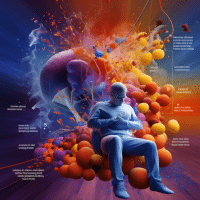Ketones & Ketoacidosis – What Is This?

Ketoacidosis is a condition that occurs in people with diabetes that is uncontrolled. It is a serious condition that must be evaluated by a medical professional quickly to prevent serious complications. Below, we’ll briefly discuss how it happens and what the major red-flag symptoms are.
The Organs & Mechanism:
Diabetic ketoacidosis develops when our will not take in or process insulin and our cells begin to feel starved for nutrition. Nutrition translates to energy. Glucose is one of three primary energy sources. (More in other articles concerning the other two.) When our body cannot process glucose, due to either a lack of the molecule or a failure of insulin to unlock the cell to absorb it, our body will begin burning fat as a means of energy. When our liver steps in to complete this process, it produces ketones and ketoacids. When our insulin does not appropriately cause our cells to respond, our liver continues to pump out these ketones and acids. The rise in the ketoacids causes a significant change to the pH level in our circulating bloodstream. These changes cause a rapid buildup of other chemicals as the body fights to protect itself, which in turn affect your kidneys, heart, lungs, and brain.
What causes this?
Diabetic ketoacidosis can be caused by:
- An illness. An infection or other illness can cause your body to produce higher levels of certain hormones, such as adrenaline or cortisol. Unfortunately, these hormones counter the effect of insulin — sometimes triggering an episode of diabetic ketoacidosis. Pneumonia and urinary tract infections are common culprits.
- A problem with insulin therapy. Missed insulin treatments or inadequate insulin therapy or a malfunctioning insulin pump can leave you with too little insulin in your system, triggering diabetic ketoacidosis.
Other possible triggers of diabetic ketoacidosis include:
- Physical or emotional trauma
- Heart attack or stroke
- Pancreatitis
- Pregnancy
- Alcohol or drug abuse, particularly cocaine
- Certain medications, such as corticosteroids and some diuretics
Symptoms to be watching out for:
- Excessive thirst
- Frequent urination
- Nausea and vomiting
- Stomach pain
- Weakness or fatigue
- Shortness of breath
- Fruity-scented breath
- Confusion
More-specific signs of diabetic ketoacidosis — which can be detected through home blood and urine testing kits — include:
- High blood sugar level
- High ketone levels in your urine
If you suspect you may have diabetic ketoacidosis, it is critical that you check your blood glucose number. If your number is above 300, you will need to call your healthcare professional for instructions, right at that time. If your number is above 400, this is considered an emergency and must be evaluated immediately to prevent DKA from developing. Failure to promptly address and treat this diabetes complication can result in serious conditions, including seizures, coma, stroke, and cardiac arrest. Please seek prompt care from a licensed provider should you observe any symptoms.
https://www.ncbi.nlm.nih.gov/books/NBK568717/
https://www.mayoclinic.org/diseases-conditions/diabetic-ketoacidosis/symptoms-causes/syc-20371551


















